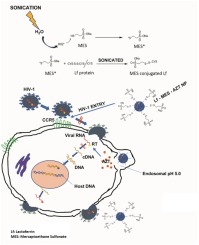当前位置:
X-MOL 学术
›
Colloids Surf. B Biointerfaces
›
论文详情
Our official English website, www.x-mol.net, welcomes your
feedback! (Note: you will need to create a separate account there.)
Sulfonate modified Lactoferrin nanoparticles as drug carriers with dual activity against HIV-1.
Colloids and Surfaces B: Biointerfaces ( IF 5.4 ) Pub Date : 2020-03-18 , DOI: 10.1016/j.colsurfb.2020.110979 Jagadeesh Senapathi 1 , Akhila Bommakanti 1 , Suresh Mallepalli 2 , Satyajit Mukhopadhyay 1 , Anand K Kondapi 1
Colloids and Surfaces B: Biointerfaces ( IF 5.4 ) Pub Date : 2020-03-18 , DOI: 10.1016/j.colsurfb.2020.110979 Jagadeesh Senapathi 1 , Akhila Bommakanti 1 , Suresh Mallepalli 2 , Satyajit Mukhopadhyay 1 , Anand K Kondapi 1
Affiliation

|
Intriguing properties and structural dynamics of Lactoferrin have been exploited in numerous applications, including its use as self-assembling, pH sensitive nanoparticles to deliver intended cargo at the disease site. In this study, we explore the possibility of surface modification of Lactoferrin nanoparticles to hone its specificity to target HIV-1 infected cells. Existence of free cysteine groups on Lactoferrin nanoparticles available for reaction with external molecules facilitates conjugation on the surface with Sodium 2-mercaptoethanesulfonate (MES). Conjugation with MES is used to edge a negative charge that can mimic CCR5 and Heparan sulfate (initial point of contact of HIV-1 env to host cell surface) electrostatic charge (Sulfate group). A simple sono-chemical irradiation method was employed for self-assembly of Nanoparticles and for surface modification. The nanoparticles serve dual purpose to abrogate extracellular entry and to target viral enzymes, when loaded with ART drugs. The morphology and size distribution of the formed particles were explored using Transmission Electron Microscope (TEM), Scanning Electron Microscope (SEM) and Dynamic Light Scattering. Raman SERS was employed to understand the difference in the protein upon surface modification. The anti-HIV property of the particles was confirmed in-vitro. The modified device demonstrated acceptable nanoparticle properties with controlled release and higher effective concentration in the area of infection.
中文翻译:

磺酸盐修饰的乳铁蛋白纳米颗粒作为药物载体,具有针对HIV-1的双重活性。
乳铁蛋白的令人着迷的性质和结构动力学已在许多应用中得到利用,包括其作为自组装,pH敏感的纳米颗粒的用途,可将其运送到疾病部位。在这项研究中,我们探索了乳铁蛋白纳米颗粒的表面修饰以磨练其针对HIV-1感染细胞的特异性的可能性。可与外部分子反应的乳铁蛋白纳米颗粒上游离半胱氨酸基团的存在促进了表面与2-巯基乙磺酸钠(MES)的结合。与MES的结合用于消除负电荷,该负电荷可以模拟CCR5和硫酸乙酰肝素(HIV-1 env与宿主细胞表面的初始接触点)静电荷(硫酸根)。一种简单的声化学辐射方法用于纳米粒子的自组装和表面改性。当负载有ART药物时,纳米粒子具有双重作用,可消除细胞外进入并靶向病毒酶。使用透射电子显微镜(TEM),扫描电子显微镜(SEM)和动态光散射对形成的颗粒的形态和尺寸分布进行了研究。拉曼SERS用于了解蛋白质在表面修饰后的差异。体外证实了该颗粒的抗HIV特性。改进的装置显示出可接受的纳米颗粒性质,具有受控释放和在感染区域的较高有效浓度。当装有抗逆转录病毒药物时。使用透射电子显微镜(TEM),扫描电子显微镜(SEM)和动态光散射研究了形成的颗粒的形态和尺寸分布。拉曼SERS用于了解蛋白质在表面修饰后的差异。体外证实了该颗粒的抗HIV特性。改进的装置显示出可接受的纳米颗粒性质,具有受控释放和在感染区域的较高有效浓度。当装有抗逆转录病毒药物时。使用透射电子显微镜(TEM),扫描电子显微镜(SEM)和动态光散射研究了形成的颗粒的形态和尺寸分布。拉曼SERS用于了解蛋白质在表面修饰后的差异。体外证实了该颗粒的抗HIV特性。改进的装置显示出可接受的纳米颗粒性质,具有受控释放和在感染区域的较高有效浓度。体外证实了该颗粒的抗HIV特性。改进的装置显示出可接受的纳米颗粒性质,具有受控释放和在感染区域的较高有效浓度。体外证实了该颗粒的抗HIV特性。改进的装置显示出可接受的纳米颗粒性质,具有受控释放和在感染区域的较高有效浓度。
更新日期:2020-03-19
中文翻译:

磺酸盐修饰的乳铁蛋白纳米颗粒作为药物载体,具有针对HIV-1的双重活性。
乳铁蛋白的令人着迷的性质和结构动力学已在许多应用中得到利用,包括其作为自组装,pH敏感的纳米颗粒的用途,可将其运送到疾病部位。在这项研究中,我们探索了乳铁蛋白纳米颗粒的表面修饰以磨练其针对HIV-1感染细胞的特异性的可能性。可与外部分子反应的乳铁蛋白纳米颗粒上游离半胱氨酸基团的存在促进了表面与2-巯基乙磺酸钠(MES)的结合。与MES的结合用于消除负电荷,该负电荷可以模拟CCR5和硫酸乙酰肝素(HIV-1 env与宿主细胞表面的初始接触点)静电荷(硫酸根)。一种简单的声化学辐射方法用于纳米粒子的自组装和表面改性。当负载有ART药物时,纳米粒子具有双重作用,可消除细胞外进入并靶向病毒酶。使用透射电子显微镜(TEM),扫描电子显微镜(SEM)和动态光散射对形成的颗粒的形态和尺寸分布进行了研究。拉曼SERS用于了解蛋白质在表面修饰后的差异。体外证实了该颗粒的抗HIV特性。改进的装置显示出可接受的纳米颗粒性质,具有受控释放和在感染区域的较高有效浓度。当装有抗逆转录病毒药物时。使用透射电子显微镜(TEM),扫描电子显微镜(SEM)和动态光散射研究了形成的颗粒的形态和尺寸分布。拉曼SERS用于了解蛋白质在表面修饰后的差异。体外证实了该颗粒的抗HIV特性。改进的装置显示出可接受的纳米颗粒性质,具有受控释放和在感染区域的较高有效浓度。当装有抗逆转录病毒药物时。使用透射电子显微镜(TEM),扫描电子显微镜(SEM)和动态光散射研究了形成的颗粒的形态和尺寸分布。拉曼SERS用于了解蛋白质在表面修饰后的差异。体外证实了该颗粒的抗HIV特性。改进的装置显示出可接受的纳米颗粒性质,具有受控释放和在感染区域的较高有效浓度。体外证实了该颗粒的抗HIV特性。改进的装置显示出可接受的纳米颗粒性质,具有受控释放和在感染区域的较高有效浓度。体外证实了该颗粒的抗HIV特性。改进的装置显示出可接受的纳米颗粒性质,具有受控释放和在感染区域的较高有效浓度。











































 京公网安备 11010802027423号
京公网安备 11010802027423号